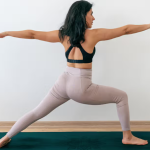Touch-a, Touch-a, Touch Me
Do you like adjustments? To me they are magic. I love receiving them, and they can make me aware of a part of my body in a flash. They can help me feel a pose in a whole new way and I can feel tension melt away with the slightest, compassionate touch.
To touch can be to give light.
~ Michelangelo
Other days, I want to hang a “Do Not Touch” sign around my neck. I’m rocking this pose to the best of my ability today and this is perfect for me right now. On these days I dread the well-intentioned teachers who come along and ‘fix’ my downward dog. I feel like there isn’t an opportunity to respectfully say, “Thanks, but no thanks, this is how I want to do downward dog today.” It might not look like a perfect posture to them, but I am exploring my body and for me that’s enough.
What Is “Perfect Posture” Anyway?
It’s no news that all our bodies are different, and different each day, but is there any need for teachers to correct posture? Some may argue that physical adjustments are unnecessary and sometimes confusing and should only be used if the student is in danger of hurting themselves. But I think, done at the right time in the right way adjustments can be invaluable.
So from a teacher’s perspective when is the right time to give adjustments?
I think that there are a few points up for discussion here:
1. The Art of Asking
I have found that it is rare that teachers ask before they adjust me. Personally, I’m okay with that, but I can’t speak for anyone else. My biggest goal as a yoga teacher is to create a welcoming and safe space for people to come practise, so I operate under a few rules:
- We can’t assume anything about our students.
- We don’t know what injuries or traumas our students may be working with.
- We are responsible for including and respecting everyone and understanding that everyone’s needs are different.
At the beginning of my classes when everyone is in Child’s Pose I’ll say something like, “during this class I will be coming round and giving physical adjustments, if you would prefer not to be touched please put your thumbs up now.” By asking this while everyone’s eyes are closed, I hope that encourages my students to be honest with me without worrying about what others might think. Alternatively, when I come round I will quietly say, “is it okay if I touch you?”
2. Adjustments For Beginners
I worry that too many adjustments can discourage people who will think they aren’t doing it ‘right’, or that my moving them is a criticism.
For newbies, I use a lot of verbal adjustments. I remember when I first started yoga everything felt alien in my body. I couldn’t possibly focus on the position of my feet and my shoulders, but eventually everything connected. Knowing this, I explain everything in detail and encourage beginners not to feel overwhelmed. Think less, feel more is my mantra.
3. Are You Comfortable?
Do you like giving adjustments? If the answer is no, don’t do it! Be authentic and trust yourself. In time you might find you start giving more (or fewer) adjustments. Or you may never give any at all! Your students value you for all that you are, so don’t try and fit in to the mould of what you think is required of you.
4. How To Give Adjustments
The question isn’t simply whether to adjust, but how and when. Why are you giving this particular student this particular adjustment? Some different types of adjustment to consider:
- To help bring awareness
- To correct alignment and prevent injury
- To help avoid strain
- To help find a deeper stretch
- To support an area of the body to allow release elsewhere
- To assist in relaxation
I generally go by the idea that less is more. Unless I know the student’s practice well I will never give big, deep adjustments. What is it that you are hoping to help with and how are you communicating? Just two fingers on the shoulders to indicate to release them can be very powerful.
Oh, and go slow! This might seem like a no-brainer, but I’ve had my arm twisted and yanked and that is not comfortable. I’ve been pushed into a forward bend when I don’t feel ready. If you don’t know someone’s range of mobility, be gentle with them.
5. Science, Baby!
I’m talking dopamine, I’m talking oxytocin. Human touch is an important part of our health and wellbeing. Some of the proven effects of human touch:
- Boosts immune system
- Reduces stress
- Eases depression
- Lowers heart rate
- Fights fatigue
Essentially, touch is a form of connection and communication. It’s a way of saying, “I am here for you and I support you.” “I see you.”
Touching Base With You
We live in a culture where touch outside of intimate relationships or a family unit can be a real taboo. It’s a sobering thought, and I really feel it if I go a few days without human contact.
I deeply value the help and compassion of all my teachers. On more than one occasion I’ve found myself crying or laughing when a teacher has helped me to release something I was carrying. I’ve had “Aha!” moments, I’ve had “Oh right!” moments, and I’ve had moments where teachers have assisted me into postures I didn’t think I was capable of.
That’s just me though. Have you ever received an adjustment you were grateful for, or felt like you didn’t need? How would you want your teachers to approach giving adjustments? I am more than curious to know your opinions and would be so grateful to hear them. Please comment!













